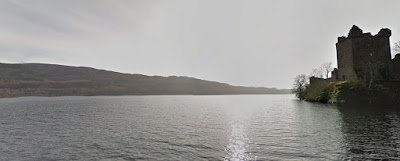I want to clarify something before I go onto the analysis of various photographs and films this year, such as the O'Connor, Cockrell and Taylor images. Clearly, such images are controversial and generate claims and counter claims.
The bottom line is how do you prove a photo or film depicts the Loch Ness Monster? Even when you have a purported close up shot of something consistent with eyewitness testimonies, you are going to get interpretations of the photograph that attempt to prove fraud (or, less likely, misidentification).
Despite what people will tell you about photos and films being objective data which lends towards objective analysis, this is not always the case (if at all). The reason for this is because all interpretations have a degree of subjectivity, be it in assumptions made about numbers or what a small, blurred section of an image is showing.
As you can see, guesstimation and blurriness are the antithesis of objective analysis. That's why when even so-called critical thinking is brought into this arena, you can assign large error bars to a lot of what passes for analysis. That, of course, applies to both sides of the debate. The trouble is, some people think they are immune from such things.
So, how do you prove a photo is a Loch Ness Monster? What is the acid test for monster? Long neck? Hump like an upturned boat? Shiny, leathery skin? All valid tests, but fakeable features to varying degrees (especially in this age of CGI). That, of course, does not mean every picture is a fake, but when these arguments are brought against a photograph or film, it is the motivation of the pro-Nessie analyst to answer them.
In fact, the main modus operandi of this blog in this regard is to disprove counter arguments against photos and films, or at worst expose their weaknesses. And, to borrow from Sherlock Holmes, having eliminated the improbable, whatever remains, however improbable, must be the truth.
Well, that is the ideal to aim for, but everyone is influenced by their internal prejudices and biases. There is nothing that can be done about that, and everyone who reads will make their own minds up.
As an aside, photos are also assessed on the basis of how consistent they are with the overall story. For example, I reject the so called "gargoyle" photo taken underwater by the Academy of Applied Sciences in 1975. The basis for this is simply that what this photo purports to show bears little resemblance to what eyewitnesses have described concerning the head and upper neck of the creature.
In fact, not all Nessie photos are created equal. We will all have our own ratings for each photo across time. I myself will rate such images on a personal scale taking into account arguments both for and against the image in question. For example, the Surgeon's Photograph is a fake to me, and on a for-against percentage rating, I would give it 20-80, meaning my opinion is that I am 80% certain of the arguments against it being real and give 20% to the arguments that it is real.
But there are pictures which I do regards as images of the Loch Ness Monster and I give them, on balance, positive ratings. So, I give the Hugh Gray photo a rating of 90-10 and for the Peter MacNab picture, I give 80-20. Nearer the line of indecision (50-50), I rate the so called F.C.Adams photo at 55-45, purely on the basis of the back story I unearthed last year.
And, of course, we have the many pictures which show distant wakes and blobs. They may be monsters or they may be something else. These will be near the 50-50 line as we simply do not have enough information to assess them.
People who take a 100-0 or a 0-100 stance on many or all pictures probably need to ask themselves a few questions about what motivates their assessment of the evidence. Remember these points when I present various articles on Loch Ness Monster photographs and films.
The author can be contacted at lochnesskelpie@gmail.com


































